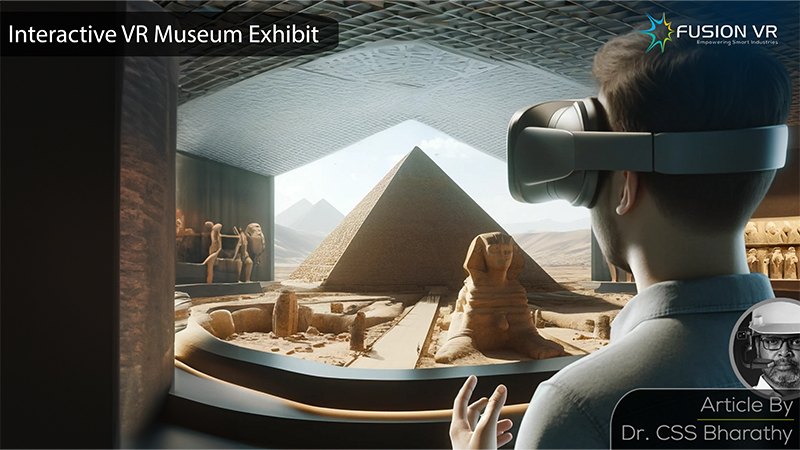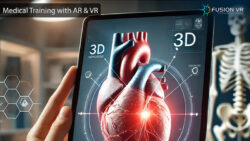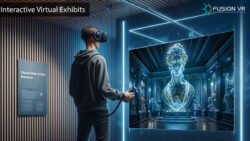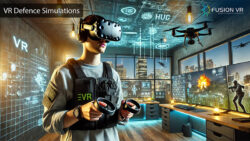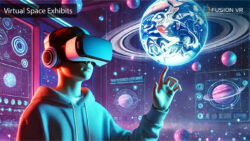There are many technologies that are deployed to successfully create an interactive and immersive virtual reality museum experience. The real skill behind the implementation of these technologies requires a deep understanding of the capabilities and limitations of each technology and combining them expertly to provide the most engaging experience for all museum visitors. This is something that Fusion VR has consistently demonstrated in each of its museum projects across the country.
Museums have been embracing newer technologies since the 1990s as computer and communication technologies became mainstream and more affordable. Many new technologies have contributed to the growth of digital and virtual museum experiences, particularly during the last decade. Virtual reality and augmented reality are spearheading the transformation of traditional museums into new age high tech digital museums. We will no longer view museums as a place that we visit with our kids to view antiquated stuff a few times in our lives. With this transformation, Museum 2.0 is the new paradigm for museums of the 21st century.
Virtual reality is this amazing technology that allows us to view a completely recreated digital world that is viewed using an expertly designed headset that completely cuts us off from the real world surrounding us. The headset has optics, displays and some amazon circuitry and programming which allows us to view this digital world. As we turn around, the scene we see changes much like the real world around us. One can move around in this virtual world with the aid of hand controllers and perform activities as well. The amazing thing about virtual reality is that it convinces our brains that we are in a real world. This characteristic of virtual reality is what makes it so appropriate for creating great exhibits and experiences. Let’s see what are the other technologies that are necessary for creating VR exhibits in museums.
One of the most important technologies is the software tools such as Blender, Maya and Zbrush that are necessary for creating 3D models. These applications are necessary for creating 3D assets that are used in various VR applications. For example, Blender is used for both modeling and rendering 3D creations. It is also open source and very powerful. Maya is another application that helps with 3D modeling, visual effects and animation while ZBrush helps with creating a high level of detail and advanced sculpting techniques for model creations. 3D models are also developed using photogrammetry by capturing high resolution images of an object from various angles. It then uses sophisticated software such as Agisoft Metashape or RealityCapture that helps to generate a detailed 3D model. In museums, this is a safe and accurate way to create highly realistic models of the most treasured artifacts. For example, the British Museum in London, UK has used Blender and Maya to create 3D models of valuable artifacts. The Smithsonian Institution has used the technique to create highly detailed 3D scans of the Apollo 11 command module that took astronauts to the moon and back. These are a few of the proven examples of how these technologies are used worldwide.
The next set of technologies in museums are the game engines which are essential for virtual reality development. They support real time rendering and deliver advanced visual effects that are behind some of the most visually stunning and highly realistic virtual reality environments. The Anne Frank House has VR tour experiences that are developed using Unity. Also the Vatican Museums have developed virtual reality tours that provide an immersive experience of the world famous Sistine Chapel.
Walk into the Louvre and you will find them using Oculus VR headsets for their Mona Lisa VR experience center. Today there are many crucial technologies that are driving the amazing hardware such as VR headsets which have become lighter and more cost effective during the past decade. Companies like Oculus, HTC, Playstation etc. have contributed to the growth of these technologies that have made VR technologies more accessible to museums as well as the general public. The latest is technologies that help to track head movements which are used to provide a more realistic experience in the virtual space. These companies are also experimenting with spatial computing technologies that minimize the need for hand controllers and deliver an experience that is more closer to a real life scenario.
Technologies that facilitate VR development are also on the rise. For example, Open XR is establishing itself as a standard for cross platform virtual reality development opportunities and helps provide a common API across various types of virtual reality hardware. This platform is driving ease of development and greater compatibility in the VR technology ecosystem. In addition to that, Software Development Kits or SDKs like the SteamVR SDK and Oculus SDK provide a wide selection of libraries and tools for developers to effectively leverage the various features available with their hardware. The Guggenheim Museum uses Oculus SDKs and the Virtual Reality Museum of Immersive Experiences uses the Open XR platform for integrating immersive audio features that help deliver great visitor experiences in their VR museum exhibits.
The audio experience is a critical contributor towards creating a convincing immersive experience with VR. Spatial audio technology tools such Wwise, FMOD etc help with the development of realistic sound environments or soundscapes. This audio design technology helps us perceive sounds as they occur in natural spaces with correct recognition of direction, distance, intensity etc. Voiceover is also an important element of the VR museum experience that provides direction and information relevant and contextual in nature.
With the growth of 5G networks across the globe, the demand for VR technology in museum experiences has also grown. Virtual museums that recreate real life museums provide accessibility to a global audience. These museums expose their artifacts with almost no cost. High speed connectivity provides a seamless and smooth experience allowing visitors to enjoy and appreciate these artifacts for an unlimited amount of time. Technologies like WebXR and WebVR enables VR museums to be experienced using web browsers eliminating the need for any special software applications. The Louvre museum uses WebXR for its virtual museum experience. Multiple users can also interact among themselves with the aid of technology frameworks such as Photon and Mirror. Such capabilities create the possibilities for collaboration and social interaction between users.
The market for VR in musuem applications in general and more specifically for museums is growing rapidly. This demand is fueling the growth of technologies to deliver more realistic, immersive and engaging visitor experiences. The development is both in applications and hardware required for virtual reality exhibits. A host of other technologies for displays, optics, electronics is growing to support the delivery of high quality exhibits. Fusion VR keeps abreast of the technology trends and advances in the field of virtual reality to benefit our clients and future customers. As one of India’s leading digital museum solutions companies, we help governmental and private customers with the right technology advice and help them make better choices for their target audiences.
Virtual reality and the technologies that drive the development of applications and the installation of exhibits and experiences are crucial for the preservation of valuable historical artifacts. VR is a great technology not only for immersive, interactive museum experiences but also for the education of the nation’s young minds. These exhibits enable a deeper understanding and appreciation of the events that shaped the course of our country. Fusion VR is making its contribution to the development and growth of Museum 2.0 as well as the virtual reality educational and commercial ecosystem in India.

